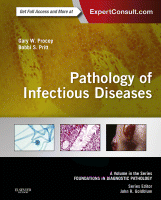Physical Address
304 North Cardinal St.
Dorchester Center, MA 02124

Tuberculosis Clinical Features Prevalence Tuberculosis remains one of the most important diseases in the world. Although the DNA of the microorganism responsible for tuberculosis has been recovered from ancient Egyptian mummies, the profound increase in the incidence of the disease…

Introduction Rickettsial infections are caused by related obligate intracellular bacteria in the families Rickettsiaceae (vasculotropic rickettsioses) and Anaplasmataceae (ehrlichiosis and anaplasmosis). Clinical similarities among these infections result from alterations or injury to vascular endothelial cells, either by direct infection and…

Introduction Several bacterial species included in the genus Bartonella, and the pathogens Coxiella burnetii and Tropheryma whipplei, cause a remarkably wide and diverse spectrum of infectious disease syndromes that pose particularly difficult diagnostic challenges for anatomic pathologists. These agents stain…

Introduction Anaerobic bacteria are normal flora of human skin and mucous membranes of the gastrointestinal tract including the mouth. Anaerobic bacteria can be classified according to their oxygen requirement in culture. By definition, anaerobic bacteria do not grow on solid…

Enteric pathogens are the leading cause of childhood death in the world and the second leading cause of death for people of all ages (second only to cardiovascular disease). In many areas of the world, problems with water quality, sanitation,…

Introduction Botryomycosis, from the Greek botryo, meaning “grapes,” is a rare, chronic infection of the skin and viscera. This ancient name for the disease with the use of “mycosis” is actually inappropriate and misleading, because the infection is caused not…

Introduction Clinical Features Mycetoma is a much neglected tropical disease affecting the poorest people of countries in which it is endemic. Mycetoma may be defined as “a pathological process induced by exogenous fungi and actinomycetes producing grains” (Barquisimeto, 1978). If…

Introduction The microorganisms covered in this chapter all have the common characteristic of being partially acid fast but unable to retain carbol fuchsin in the presence of a strong acid decolorizer (i.e., they are not fully acid fast). This chapter,…

Introduction Bacterial infections in the lung can be divided into those that are the typical causes of respiratory infections ( Streptococcus, Staphylococcus, Pseudomonas, Haemophilum, and Klebsiella ) and those that are classified as unusual or atypical causes of these infections…

Introduction Infective endocarditis (IE) is a broad term used to designate an infection on any of the anatomic components of the heart and their endothelial surfaces. These include the atrial and ventricular endocardium, valves and their apparatuses, and prosthetic or…